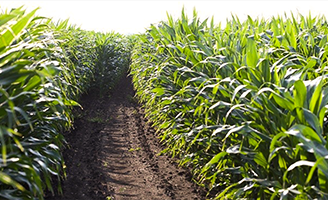 From the moment it’s applied, nitrogen is at risk for loss. If not managed properly, up to 30% of nitrogen loss can happen above ground, and up to 70% can be lost below ground, producing serious crop quality (and, therefore, economic) concerns.
From the moment it’s applied, nitrogen is at risk for loss. If not managed properly, up to 30% of nitrogen loss can happen above ground, and up to 70% can be lost below ground, producing serious crop quality (and, therefore, economic) concerns.
By late summer, you should be able to visually identify how your corn crops are taking up nitrogen. Based on a few visual tests, along with soil tests for confirmation, you’ll be able to see how accurate your nitrogen application plan was, how spring and summer weather have impacted nitrogen use thus far, and what you might expect come harvest.
What happens if corn doesn’t have enough nitrogen?
Applied nitrogen can be lost through leaching (the loss of nitrates into the groundwater) and denitrification (the escape of greenhouse gases into the environment). If a plant can’t absorb enough nitrogen through the soil, it will cannibalize its internal sources of nitrogen — draining strength from its stalk and leaves. When that happens, weakened cornstalks, stalk rot and significantly reduced yield can result.
Signs of nitrogen deficiency in corn
Fields at the highest risk of nitrogen loss include fall- and preplant-applied nitrogen fields, those composed of sandy soils and fields with poor drainage. When scouting your fields for signs of nitrogen deficiency, look for the following:
- Firing of leaves (yellowing that begins at the top of the leaf and progresses along the midrib)
- Pale-green color
- Stunted growth or spindly stalks
- Small ears, and the kernels at the tip of the ear do not fill (for harvest corn)
How to address nitrogen loss
Finding a nitrogen deficiency at this point in the season is frustrating, disappointing and can leave you wondering: What do I do now?
“Some may consider a late-season nitrogen application as a rescue. This would only apply to V8 to V12 corn that is waist high to tasseling. But you’re gambling here,” said Scott Pringnitz, Corteva Agriscience market development specialist. “Consider applications at the first sign of loss, soil testing and visual tests. If you see deficiency, then you already have seen yield loss.”
Unfortunately, little can be done if nitrogen deficiencies are found at this time of year. It does, however, provide some key information and learnings so that you can adjust your nitrogen management plan for next year.
If nitrogen deficiencies are found in your fields this summer and fall, here are some tips to consider for next year:
- Reconsider the type of nitrogen you are applying. Depending on weather in your area, the soil type and application timing, a switch from UAN to urea or to anhydrous ammonia and vice versa may be a better fit for your fields’ needs and your loss factors.
- Adjust the application timing. Again, based on weather and soil type, you may consider switching when you apply your nitrogen. Depending on these factors, you may need to adjust to ensure you have the maximum amount of nitrogen available when corn needs it most, during vegetative stages prior to flowering.
- Include a nitrogen stabilizer in your application. Nitrogen stabilizers protect nitrogen from loss and help ensure it stays in the root zone during critical growth periods for maximum crop uptake. N-Serve® and Instinct® nitrogen stabilizers work below ground to help prevent leaching and denitrification for any fertilizer type. N-Serve works with anhydrous ammonia, while Instinct maximizes nitrogen when used with UAN, urea and liquid manure.
A holistic approach to nutrient management
Realizing maximum yield in the fall not only relies on nitrogen, but also benefits from a holistic approach to nutrient management. This includes making sure phosphorus (P) and potassium (K) levels are adequate to support growth throughout the entire season and protecting nitrogen (N) applications with a nitrogen stabilizer. Remember: Nitrogen remains the staple nutrient required to maximize corn yield.
Soil fertility levels for P and K are affected by:
- Their inherent availability in the soil
- Past crop removal amounts
- Soil pH
By supporting your nitrogen applications with a comprehensive approach to nutrient management, you’re covering all your bases when it comes to realizing the yield potential on your cornfields.
Instinct is not registered for sale or use in all states. Contact your state pesticide regulatory agency to determine if a product is registered for sale or use in your state. Federal law does not require any person who applies or supervises the use of Instinct to be certified in accordance with EPA regulations and state, territorial and tribal laws. Some states may have additional requirements related to liquid manure and nitrogen stabilizers. Be sure to consult your state or local Extension service to understand your requirements. When applying Instinct to deep pits, appropriate manure agitation safety steps should be followed. Instinct should be applied directly to the deep pit prior to pumping the pit; a thorough agitation system must be operating in order to evenly distribute Instinct within the deep pit; applicators and handlers of Instinct and manure treated with Instinct are required to use proper protective equipment as stated on the product label; air ventilation systems must be operational inside barns. Do not fall-apply anhydrous ammonia south of Highway 16 in the state of Illinois. Always read and follow label directions.
The More You Grow
Find expert insights on agronomics, crop protection, farm operations and more.